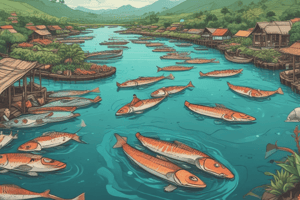Podcast
Questions and Answers
What does 'fisheries' refer to?
What does 'fisheries' refer to?
All activities relating to the act or business of fishing, culturing, preserving, processing, marketing, developing, conserving, and managing aquatic resources.
What is aquaculture?
What is aquaculture?
The farming of aquatic organisms in inland and coastal areas with intervention in the rearing process to enhance production.
In which year did the Philippines rank 8th among the top fish producing countries?
In which year did the Philippines rank 8th among the top fish producing countries?
2018
What was the total value of the Philippines' aquaculture production in USD?
What was the total value of the Philippines' aquaculture production in USD?
Which type of aquaculture involves organisms living in freshwater?
Which type of aquaculture involves organisms living in freshwater?
What is the main objective of seed production in aquaculture?
What is the main objective of seed production in aquaculture?
Match the following aquaculture production types with their objectives:
Match the following aquaculture production types with their objectives:
What is the defined stocking rate in aquaculture?
What is the defined stocking rate in aquaculture?
Which type of aquaculture is characterized by low investment and low yields?
Which type of aquaculture is characterized by low investment and low yields?
Semi-Intensive Aquaculture uses low stocking rates and minimal feed.
Semi-Intensive Aquaculture uses low stocking rates and minimal feed.
What is considered intensive culture's stocking rate?
What is considered intensive culture's stocking rate?
Flashcards are hidden until you start studying
Study Notes
Fisheries
- All fishing-related activities, including aquaculture, resource conservation, and management are considered fisheries. This definition considers both traditional and modern fishing practices.
Aquaculture
- Refers to the controlled breeding and raising of aquatic organisms in both inland and coastal areas, including fish, crustaceans, and mollusks.
- It's a crucial part of fisheries, contributing significantly to global food security.
Aquaculture Production in the Philippines
- The Philippines is a major player in global aquaculture, ranking 8th in total fish production and 11th in aquaculture production in 2018.
- The country's aquaculture production totaled 826,010 metric tons, representing 1.01% of the global aquaculture production.
- The total value of the Philippines' aquaculture production in 2020 was USD 1.89 billion.
- The Philippines is also a leading producer of aquatic plants, including seaweed, ranking 4th in the world with a total production of 1.48 million metric tons in 2020.
Aquaculture Classifications
- Aquaculture is classified based on the aquatic environment (freshwater, brackishwater, mariculture), end-product (seed production, grow-out production, broodstock production), and level of intensity.
Aquatic Environment
- Freshwater Aquaculture: Cultivation of organisms in inland waters with low salt content (less than 0.1 parts per thousand).
- Brackishwater Aquaculture: Culture of organisms in water with salinity levels between 0.1 parts per thousand and full-strength seawater.
- Mariculture: Cultivation of organisms in coastal lagoons or the open sea.
End-Product
- Seed Production: Focuses on producing small fishes or organisms (seed) for stocking ponds or other culture devices.
- Grow-out Production: Aims to raise seed stock to commercial size or weight.
- Broodstock Production: Aims to grow, breed, and improve cultured species genetically to enhance aquaculture productivity.
Level of Intensity
- Extensive Aquaculture: Characterized by low stocking rates, minimal use of supplemental feed, and low investment leading to low yields.
- Semi-intensive Aquaculture: Higher stocking rate and use of both fertilizers and feed, leading to higher investment and higher yields.
- Intensive Aquaculture: Uses the highest stocking rate with significant supplemental feeding, water exchange, and mechanical aeration, requiring high investment and potentially maximizing yield.
Stocking Rate vs Stocking Density
- Stocking rate refers to the number of fish seed per unit of water surface, taking into account age and size.
- Stocking density refers to the total number of animals or their liveweight in a specific area for a given period.
Fish Seed
- Refers to fry, post-larvae, and fingerlings of the species being cultured. They are typically sourced from natural waters or hatcheries.
Extensive Culture
- Utilizes low stocking rates, relying on natural fertilization for food availability. Requires minimal technology and minimal investment, leading to minimal yield.
Semi-intensive Culture
- Higher stocking rate than extensive, combined with fertilizer application and supplemental feeding. Requires more technology and investment, leading to higher yields.
Intensive Culture
- Highest stocking rate requiring large amounts of supplemental feed, frequent water exchange, and mechanical aeration. Requires maximum investment and technology for potentially maximum yields.
Studying That Suits You
Use AI to generate personalized quizzes and flashcards to suit your learning preferences.



